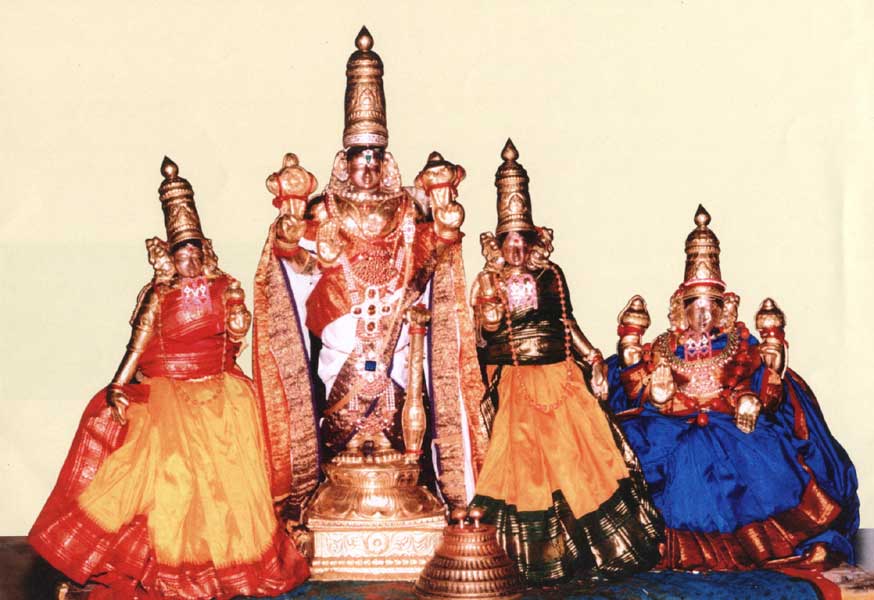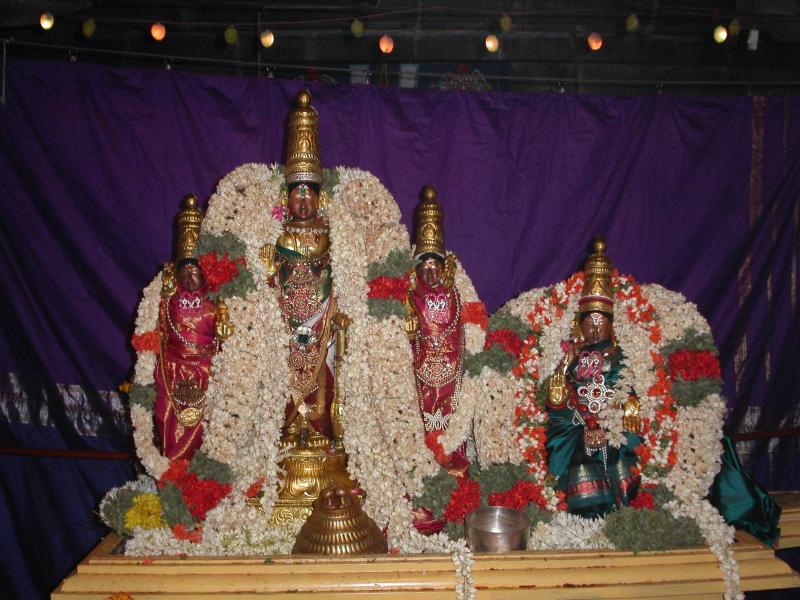Sahasranama tatulyam rama namam varanane ||
The Divine name Sri Rama has the capacity to stop a departing soul.At the same time the Divine name Sri Rama ie. Sri Vijayaraghava, can also facilitate reaching Moksham. We have come to Thiruputkuzhi and had darshan of Gruddhara Pushkarini. We can also worship Jatayu, worshiping the Lord. After entering the temple, beyond Gopuram, we find beautiful prakaram [corridor]. As we go round the prakaram, we find number of monkeys on trees. Monkeys, perhaps, suggest that we are in Sri Rama's place. We enter the temple further and see ardha mandapam, maha mandapam and garbha gruham. Thirumangai Alwar has praised the Lord of this Kshetram in 2.7.8 pasuram. This pasuram is engraved in the temple. Alwar assumes a woman form in this pasuram. 'She' is the mother of the sweet heart of the Lord. 'She' pleads with the Lord to accept 'her' daughter, as 'her' daughter is madly in love with the Lord. 'Mother' says that 'her' daughter had lost herself to the sweet tunes coming from the flute, Cowherd Sri Krishna was playing. 'She' further says that 'her' daughter was singing in praise of Thiruputkuzhi, which has water, perhaps Gruddhara Pushkarini water, capable of attracting all sense organs. Today's [19th November 2008] lecture is from the sannidhi of the Lord. The Lord is Sri Vijayaraghavan or Sri Samarapungava [samara = war or fight, pungava = skilled] or Sri Poreru [por = war, yeru = bull]. Always victorious in any fight, is an attribute to Sri Rama. Another proof that the Lord here is Sri Rama, is that the Avatar day of the Lord here is Chitra [சித்திரை ]month, Punarvasu [புனர்வஸு ] star, identical with the birthday of Sri Rama. We will now worship the Moolavar.

The Lord is in seated pose. Left hand is ready to embrace Jatayu to perform the last rites and is in ahvahana mudra. Right arm is displaying abhaya. On His right is Sri Bhudevi and on the left is Sri Sridevi [ yes, positions are different from normal!]. We may have a doubt as to how, during the performance of last rites to Jatayu, Sri Sridevi and Sri Bhudevi could be with the Lord? This incident took place while searching for Sri Sita, was it not? We should remember that the Lord is enacting that incident which took place long ago, for devotees' benefit, here and now! But to prove that the incident took place, the Consorts are inter changed. Unbearable of the heat from the pyre, Consorts are inter changed and appear to be bending Their heads away from fire! Swami Kooratalwan poses a question to the Lord. The Lord granted Moksham to the bird. Arcchiradi marg, invisible for others, was visible to Sri Rama! That is He was able to see the path for Vaikuntam. But then how He was not aware of the place where Sri Sita was imprisoned? The Lord it seems cried ignorant of Her place! Thus the Lord having taken the guise of a normal human, suddely forgot His role and displayed He was the Paramatman, in this Jatayu incident! Also, He granted Moksham to Jatayu, who did nothing to obtain that position. Therefore, if the Lord wills, He can grant anything including Moksham. Also, it is impossible for the Lord to hide His true qualities! Swami Desika says that the Lord has an identification mark on Him. That is the scar of burning the body of Jatayu on the pyre - gruddhraraja deha vibaksha. That identity reminds us that the Lord is full of mercy - vatsalyam - towards His devotees. He would do anything for the devotees. This Swami Desika tells in Raghuvira ghatyam - bhakta jana dakshinya! We will now worship the Utsavar.


But we can do that as we study sloka 40 of Chapter 11. By appreciating the sloka, we can have a grand view of the Lord. Earlier, Arjuna repeatedly saluted the Lord by utteing the word nama:. He continues in sloka 40:
namah purastad atha prsthatas te
namo ’stu te sarvata eva sarva
ananta-viryamita-vikramas tvam
sarvam samapnosi tato ’si sarvah
"Obeisances to You from the front, from behind and from all sides! O unbounded power, You are the master of limitless might! You are all-pervading, and thus You are everything!"
Arjuna says that the Lord is everywhere around. Without exception He is pervading in everything. So Arjuna prefers to call Him, Sarva = Whole. Are not others separate from Him? Yes, all are different from Him, but it is He, Who is the Antaratman in all and controlling and commanding all. Purastad = to [Your, Sri Krishna's] front, nama = [I, Arjuna] salute, atha = also, prsthata = from [Sri Krishna's] behind, namostu te = salute You [Sri Krishna], sarvata = from all sides [salutations], sarva = [the Lord as a] Whole. The Lord is Whole and so Arjuna offers salutations from front, behind and from every side. Ananta-virya = boundless valour, amita = beyond description, vikrama = powerful, sarvam = all in this Universe, including all chetana-achetana [movables and non-movables or with or without knowledge], samapnosi = pervading [without exception], tata = therefore, sarva = everything [Sri Krishna is]. Earlier Arjuna mentioned the names of certain gods, and told that the Lord was all of them. Before that we also saw that Arjuna mentioned that the Lord was chit, achit, baddha and mukta, etc. Arjuna tells that the Lord is inanimate objects like stone, mud, etc., and also says that the Lord is superior beings like Agni, Vayu, etc. He says lord Brahma also is Sriman Narayana. That is everything from mud, tiny grass to animals, birds, etc., to Devas, is the Lord, Arjuna says. Reason for mentioning that is Arjuna tells here; that the Lord is pervading all without any exception. We see a pillar made of stone and call it as stone pillar; a ring made of gold, as gold ring; a dhoti made of cotton as cotton dhoti. Since the Lord is pervading all, it is correct to call the pillar as Bhagavan pillr; to call ring as Bhagavan ring; to call a dhoti as Bhagavan dhoti. That is why Arjuna calls everything - Vayu, Agni, Varuna, everything - as He, the Lord. His valour is beyond our imagination. Sri Rama -Sri Vijayaraghava - symbolises valour. When we worship the Lord Utsavar from His front, we see His abhaya mudra, allaying all our worries and fears. He graces with left arm firmly holding the mace and with the Consorts. Nearby, yet another Utsavar, without Consorts, is also gracing. This Kshetram is also famous for the 'keel kudhirai' [mechanical horse கீல் குதிரை].
On the Eighth day of Brahmotsavam, the Lord mounts this Horse. The Horse has many mechanical features, which enable the Horse to make movements; and for the spectator, it would appear as though the Lord was riding a real Horse! On days other than Utsavam day, the Horse is disassembled and kept as Three parts. It is because of the belief that if kept assembled, the Horse might run away! The carpenter who designed and fabricated this Horse, dedicated the Horse to the Lord and vowed not to make another for any other temple. When he was forced to make another, he preferred death at His feet. Even today, as a mark of appreciation, the Lord visits the locality of carpenters in this place on Horse vahanam day, before continuing His procession. We also would offer our obeisances to the Lord, on the Horse, from all sides.


No comments:
Post a Comment